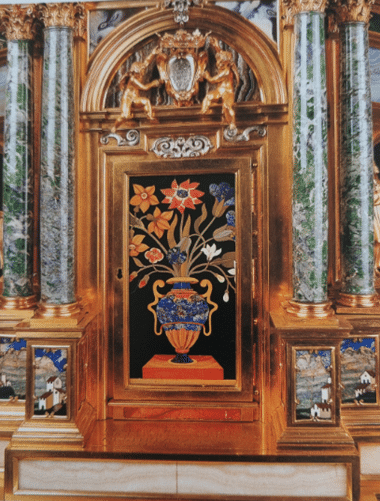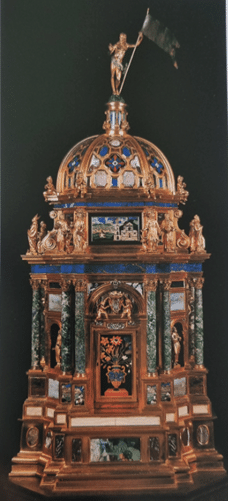- Pair of Florentine mosaic plaques. Florence, first half of the 17th century.
Pair of plaques in hardstone and rare marble inlay on a black paragone background. Resting on a grey marble shelf are two twin-handled Medici vases of similar shape, each containing a floral arrangement of different species. The two pietre dure compositions are set in a gilt bronze frame dating from the late 19th century.
Plaque dimensions (HxW): 15 x 10.5 cm; Frame dimensions (HxWxD): 17 x 12.5 x 2 cm.
CODE: OGANOG0280030
Florentine mosaic inlay, known as commesso fiorentino, emerged in the second half of the 16th century as part of the humanist revival of the ancient Roman technique opus sectile—an artistic process that used cut marbles to create inlaid floors and wall decorations. The commesso technique, characterized by the use of colored marbles and semi-precious stones, developed in Florence with a distinct preference for the latter. These materials were used to craft exquisite compositions featuring naturalistic subjects such as flowers, animals, and fruits, as well as cityscapes and reproductions of famous paintings—arranged with such skill that the final result closely resembled painting itself.
Unlike in Rome, where this technique was used almost exclusively for architectural decoration, in Florence commesso was applied to both liturgical furnishings (such as altar frontals) and luxury public and private furniture—most notably tabletops, cabinets, and decorative panels. In 1588, with the aim of producing high-value artistic objects intended for the Grand Ducal residences or diplomatic gifts, Ferdinando I de’ Medici founded the Opificio delle Pietre Dure in Florence, uniting under one roof the artisans working at court. This institution, which still operates today as a renowned center for restoration, continued its activity under the Lorraine dynasty, dedicating over three centuries—until the late 19th century—to the decoration of the Chapel of the Princes in San Lorenzo, while keeping the original technique virtually unchanged.
It is within this rich cultural and artistic context that the two plaques under examination were created. Dating to the first half of the 17th century, they were likely intended to decorate the doors of a cabinet or a tabernacle.
In this regard, an interesting comparison can be made with the tabernacle housed in the Royal Palace of Madrid, published by Gonzalez-Palacios. The plaque on the door of that tabernacle features a vase almost identical to one of the two examined here, differing only in the orange-toned shelf and the floral arrangement. The tabernacle was made in Naples by the silversmith Menico Montini in 1619. While the name of the stoneworker is unknown, it is highly probable that the plaques were sourced from Florence.
Similar subjects can also be found on the doors of various cabinets, such as the one preserved in Villa La Petraia in Florence and another in the Rosenborg Castle in Copenhagen.



FineArt is the new ambitious Di Mano in Mano project that offers an exclusive choice of antiques and design works, presenting them for their singularity and uniqueness.

FineArt by Di Mano in Mano is a team of experts at your service to enhance furniture, paintings, finest antiques, art and design masterpieces at best.
Di Mano in Mano
Via Castellazzo 8, Cambiago (MI)
20040